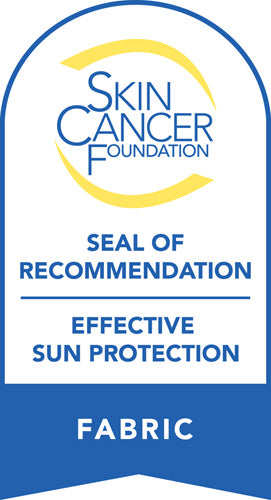If you spend a lot of time outdoors, you are likely being heavily exposed to UV rays. Here are some types of skin disease that the sun can cause...
Are you someone who loves golf, tennis, biking, or hiking?
It could be that all your hobbies are activities that get you outside so you can enjoy all those great health benefits. Although you are probably wearing sunscreen and clothes to cover your skin, have you considered how sunlight can penetrate fabric and trigger skin disease?
According to the Centers for Disease Control and Prevention (CDC), in the US, skin cancer is the most common form of cancer. Unprotected skin can suffer damage in only 15 minutes, and this UV exposure compounds over time. Individuals that already have skin disease or a sun allergy will need an even greater level of skin protection.
If you're out in the sun a lot, we'll explain the various types of skin diseases that you need to avoid. We'll also let you know what you must do to further protect your skin from harmful sun exposure. Read on!
Non-Cancerous Damage
It's not only the sun but any ultraviolet (UV) light source that can damage the skin. Tanning beds may use artificial UV light bulbs to simulate the sun but can cause equal damage.
Exposure to the UV rays of the sun can lead to photo-aging effects on your skin. There can be visible changes to your skin color, and a wrinkly texture may develop at a younger age than would otherwise be the case.
Freckles are the result of sensitivity to sunlight. Your skin may also loosen, and brown spots may appear on the body, often particularly noticeable on the hands.
Solar lentigo refers to a harmless yet undesirable patch of dark skin caused by UV radiation. Other names include age spots, sun spots, and liver spots. In response to the UV rays, melanocytes proliferate and melanin builds up within these cells of the skin.
While solar lentigo is a condition that is benign and quite common in adults over 40, pre-cancerous growths are more of a concern.
Years of exposure to the sun often lead to pre-cancerous spots, which can develop into cancer over time. Actinic keratosis (AK) can develop as a rough skin patch that has a scaly appearance. We'll cover skin cancer next.
Types of Skin Cancer
Too much sunlight and not enough protection can prompt many different skin cells to turn cancerous. Any unusual skin developments or rapid growth of an existing blemish should be immediately inspected by a dermatologist.
Basal cell carcinoma (BCC) is the most common and frequent of all skin cancers, with close to 5 million cases a year in the US. UV damage can trigger basal cells to grow abnormally and uncontrollably, leading to skin cancer. Owing to the slow growth of BCCs, if caught early, they can be successfully treated.
Another common skin cancer is known as squamous cell carcinoma (SCC). Like BCC and other forms of skin cancer, cell growth is uncontrolled and abnormal, with squamous cells damaged in this case. With early detection and treatment, this form of skin cancer is also curable.
A malignant melanoma starts in the melanocyte cells and is a less common form of skin cancer. Unfortunately, while less common, it carries a higher risk of spreading to other parts of the body, including the organs. This is because melanoma can grow more quickly than BCC or SCC.
Only about a quarter of melanoma cases are found in moles, with three-quarters appearing on skin with a normal appearance.
Xeroderma Pigmentosum
For some, skin protection requires extreme precautions. Xeroderma Pigmentosum (XP), though rare, is a disease that leads to extreme sunlight sensitivity. XP is a genetic disease, so it's present at birth.
Put simply, the body of an XP sufferer cannot fix the destructive effects of UV rays. The first word in the name, "xeroderma," refers to dry skin, which is a frequent side-effect. The second word, "pigmentosum," refers to the dark spots that often develop.
Sometimes, pre-cancerous growths are the first indicator of the presence of XP. When outside, a young child with XP might not readily experience sunburn. Often, large freckled areas can form before age 2, later leading to bigger and darker spots.
The chances of skin cancer with XP are 10,000 times that of an average person. Skin cancer will commonly develop before age 10.
UV-blocking clothes are required to prevent skin damage in individuals with XP. UV protection will also be needed for the eyes and face. Sunscreen is even required below sun-blocking clothing, especially in areas that could become accidentally exposed.
XP can also lead to eye damage, cataracts, and cancer, which may develop on both the eyes and the eyelids.
Sun Allergy
A sun allergy is known medically as solar urticaria.
Several skin conditions cause a sun allergic reaction. Essentially, this is where a red rash or hives will develop on sun-exposed skin. These itchy areas can arise in minutes after being exposed to the sun but can last for hours.
The cause of a sun allergy may not always be known. While some sun allergies might be inherited, others may be caused by the use of a prescription drug or even contact with certain wild plants.
In addition to the rash on the surface of the skin, you may develop additional allergic symptoms. These include a headache, low blood pressure, nausea, and trouble breathing.
Polymorphous (or polymorphic) light eruption can appear as small red bumps or a raised red patch. Usually, the red bumps or patch will fade within ten days, and scars aren't common. The rash can, however, re-appear the following spring or summer after repeated sun exposure.
Serious sun allergies may require treatment with steroids, and sun-protective UV clothes are necessary.
Avoid Skin Disease
We've shown that skin disease can be of genetic origin or triggered by sun exposure. Don't risk skin cancer by letting UV rays penetrate your regular outdoor clothing. This summer, make sure to continuously check the UV index and wear UPF 50+ Clothing.
If you're an outdoor enthusiast and need sun protective clothing, we can help. Our UPF rating 50+ fabrics don't rely on chemicals yet block 98% of the sun's rays, and our sun protection factor doesn't wash away. With a minimum ultraviolet protection factor (UPF) of 50%, our long sleeve tops, rash guards, tights, dresses, and accessories are excellent at looking after your skin.
Visit our online store today and shop by activity.



